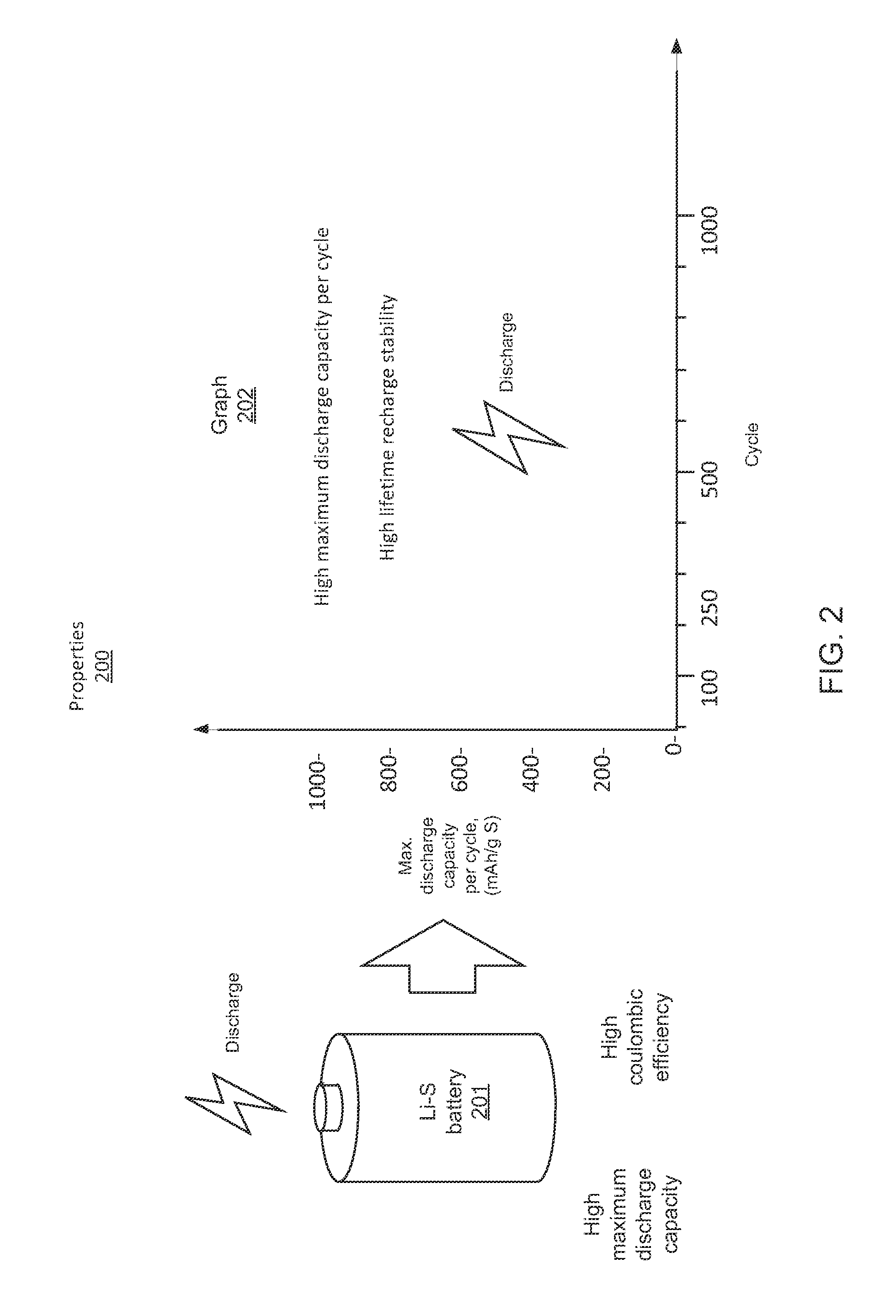Compositions, layerings, electrodes and methods for making
a technology of electrodes and layers, applied in secondary cells, battery service/maintenance, cell components, etc., can solve the problems of li—s cells and batteries, capacity degradation or capacity “fade”, sulfur loss from the total electroactive sulfur in the cell, etc., to suppress the shuttling of soluble sulfur compounds, high coulombic efficiency, and high discharge ratio
- Summary
- Abstract
- Description
- Claims
- Application Information
AI Technical Summary
Benefits of technology
Problems solved by technology
Method used
Image
Examples
example 1
[0119]Example 1 describes the preparation and electrochemical evaluation of a final layering / electrode including halogen ionomer. The final layering / electrode was prepared from a spray coated base layering / electrode incorporating a composition. The composition included C—S composite, polyisobutylene (PIB) binder and low surface area conductive carbon black. The base layering / electrode was sprayed with a halogen ionomer solution of lithium exchanged NAFION® to form the final layering / electrode. In the final layering / electrode, the halogen ionomer was predominantly located at the outer surface away from the supporting substrate.
[0120]The base layering / electrode incorporated a composition having ratio of 80 / 12 / 8 for the weight percentages of C—S composite / binder / carbon black in the composition of the base.
[0121]Preparation of C—S Composite:
[0122]Approximately 1.0 g of carbon powder (KETJENBLACK EC-600JD, Akzo Nobel) having a surface area of approximately 1,400 m2 / g BET (Product Data Sh...
example 2
[0141]Example 2 describes the preparation and electrochemical evaluation of a final layering / electrode including halogen ionomer. The final layering / electrode was prepared from a spray coated base layering / electrode incorporating a composition. The composition including C—S composite, polyisobutylene (PIB) binder and low surface area conductive carbon black. The base layering / electrode was sprayed with an halogen ionomer solution of lithium exchanged NAFION® to form the final layering / electrode. In the final layering / electrode, the halogen ionomer was predominantly located at the outer surface away from the supporting substrate.
[0142]The base layering / electrode incorporated a composition having ratio of 83 / 9 / 8 for the weight percentages of C—S composite / binder / carbon black in the composition of the base. The base layering / electrode was then sprayed with an halogen ionomer dispersion of lithiated NAFION to form a final layering / electrode. The final layering / electrode had a ratio of 6...
example 3
[0164]Example 3 describes the preparation and electrochemical evaluation of a single final layering / electrode including halogen ionomer. The layering / electrode incorporated two materials. The first material included C—S composite, polyisobutylene (PIB) binder and low surface area conductive carbon black. The second material was a halogen ionomer solution including lithium exchanged NAFION®. The two materials were applied to form the layering / electrode incorporating both materials with the halogen ionomer distributed relatively evenly throughout the layering / electrode.
[0165]The first material had a ratio of 83 / 9 / 8 for the weight percentages of C—S composite / binder / carbon black in the first material. The final layering / electrode had a ratio of 64.58 / 7.25 / 6.16 / 22 for the weight percentages of C—S composite / binder / carbon black / halogen ionomer in the final layering / electrode with the halogen ionomer distributed relatively evenly throughout the layering / electrode.
[0166]Preparation of C—S ...
PUM
| Property | Measurement | Unit |
|---|---|---|
| surface area | aaaaa | aaaaa |
| charge capacity | aaaaa | aaaaa |
| charge capacity | aaaaa | aaaaa |
Abstract
Description
Claims
Application Information
 Login to View More
Login to View More - R&D
- Intellectual Property
- Life Sciences
- Materials
- Tech Scout
- Unparalleled Data Quality
- Higher Quality Content
- 60% Fewer Hallucinations
Browse by: Latest US Patents, China's latest patents, Technical Efficacy Thesaurus, Application Domain, Technology Topic, Popular Technical Reports.
© 2025 PatSnap. All rights reserved.Legal|Privacy policy|Modern Slavery Act Transparency Statement|Sitemap|About US| Contact US: help@patsnap.com



